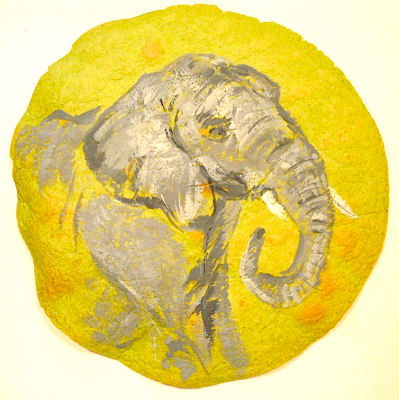While browsing through a list of artistic techniques last night, I came across this unusual art form, so I thought I'd try it for today's elephant.
Although I'd never heard of it before, tortilla art is a bona fide style, first produced by Hispanic artists in the United States. It seems to date to the early part of this century, and was originally a way of reflecting the Latino roots of the artist, since tortillas are an integral part of Latino culture. Tortillas are also seen as a form of sustenance: as the tortilla feeds the artist, the artist returns the favour by giving the tortilla new life through art.
 |
| Coyfish by Joe Bravo, 2007. Source: http://www.bookofjoe.com/2007/08/joe-bravo-is-th.html |
Well-known creators of tortilla art include Joe Bravo, Rene and Rio Yanez and Jos Sances. In addition to paintings on tortillas, some artists have branched out to create collage and multimedia tortilla art.
Today, tortilla art is produced in many parts of the world, although it remains most popular in the United States and Latin America. Exhibitions of tortilla art—often with a sociopolitical theme—have been presented around the world in recent years, from North America to Hong Kong.
 |
| Tortilla art by Rene Yanez, 2007. Source: http://www.flickriver.com/photos/elrio/443263971/ |
To produce tortilla art, a tortilla is first baked until it is hard and leathery. It is then coated with an acrylic varnish, and painted. Flour tortillas appear to be favoured over corn tortillas, and scorch marks don't seem to be a problem.
I had some tortillas on hand already, so I decided to use one of these. I decided that the green of the spinach variety might be more interesting for an elephant backdrop, so that's the kind I baked.
I baked it in a 300˚F (150˚C) oven for about 5 minutes. When it felt dry and leathery, but not crumbly, I removed it from the oven and let it cool. As you can see, the baked tortilla will develop some additional brown areas, but I actually liked that.
When it was reasonably cool, rather than coat it with varnish before I started, I began painting with acrylic paint directly on the tortilla, with plans to seal it with acrylic varnish later. I thought briefly about sketching something with pencil first, but was afraid I'd break the tortilla, so I just dove in. I did, however, use a photograph as a vague reference. This is the photograph I used:
 |
| Tara, Toronto Zoo, Toronto, Canada, 2009. Source: http://torontoist.com/2009/12/when_elephants_die/ |
I sketched the general elephant outline with grey acrylic paint.
After this, I painted so quickly that I forgot to photograph the process. It was quite easy to paint on the tortilla surface. I used paint that was almost full-strength from the bottle, as well as paint that I had really thinned down with water. It didn't seem to make much difference in terms of how well it took to the surface, although wetter paint had a tendency to soak in more quickly. It does have a bit of a weird cheese-cracker-meets-paint smell while you're working, but it's not completely unpleasant.
Interestingly, the paint doesn't spread across the surface at all. I'm not sure why that is, but I suspect it might be partly because the tortilla dough is somewhat oily, and partly because it's very dense.
This only took me about half an hour once I started painting, with an extra 45 minutes or so to bake the tortilla and let it cool. Eventually I'll probably seal the surface and the back with an acrylic varnish, but I decided to leave it as it is for now.
Odd as this technique struck me when I first read about it, I really enjoyed making this painting. It was an easy "canvas" on which to work, and has a mottled texture and surface imperfections that I liked. I also liked the way the tortilla background poked through my painting, adding visual interest.
Although I'm not sure about the practicality of preserving a work like this, I liked it enough that I will probably try it again sometime.
Elephant Lore of the Day
Elephants like corn, but prefer corn stalks to the actual cobs.
Corn stalks are much more tasty to elephants than grass, and also have far more nutrients and calories. Given the poor nutrient absorption of an elephant's digestive system, the more calories the better.
Not only have wild elephants developed a taste for corn in countries such as Tanzania, but they've also become quite clever. Although not nocturnal, they raid fields at night to avoid confrontations with humans. They also send out scouts. When a scout discovers a field that is ready for raiding, a herd of at least three to five elephants will show up the following night, trampling other cash crops in their rush to the tasty treat. Interestingly, until farmers started growing corn, elephants had no taste for it at all.
Although farmers are now using fences coated with chili pepper to deter elephants, other humans have begun taking advantage of the elephants' taste for corn. Several online sites dedicated to big-game hunting suggest that the best time to hunt elephants is just as the corn stalks are at their juiciest.
 |
| Elephants grazing in field in Africa. Photo: Rick Ray Source: http://video.shutterstock.co.uk/clip-1490527-stock-footage-two-elephants- graze-in-yellow-fields-in-africa.html |
To Support Elephant Welfare
Elephant sanctuaries
(this Wikipedia list allows you to click through to information
on a number of sanctuaries around the world)
Wildlife Trust of India






No comments:
Post a Comment